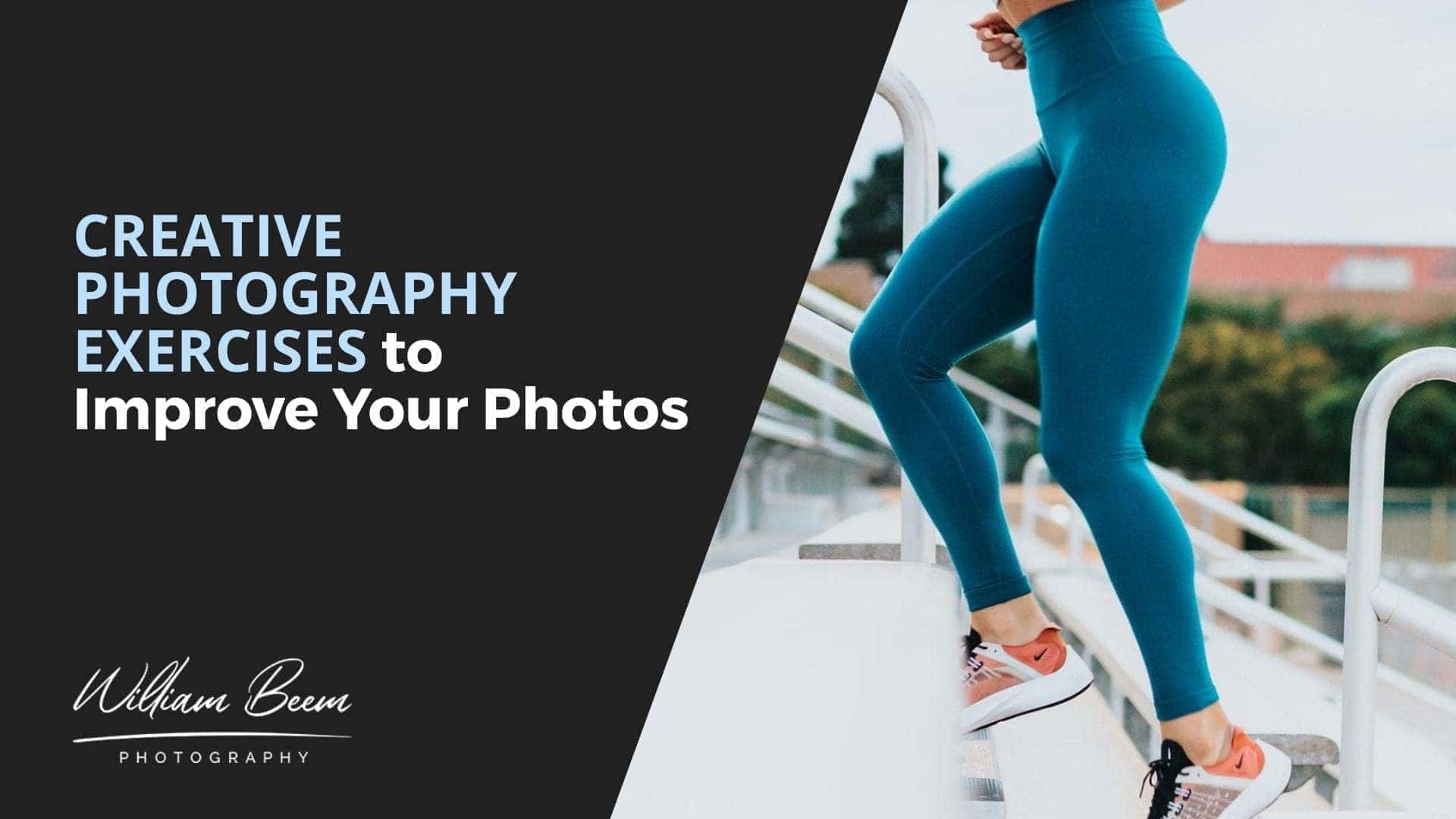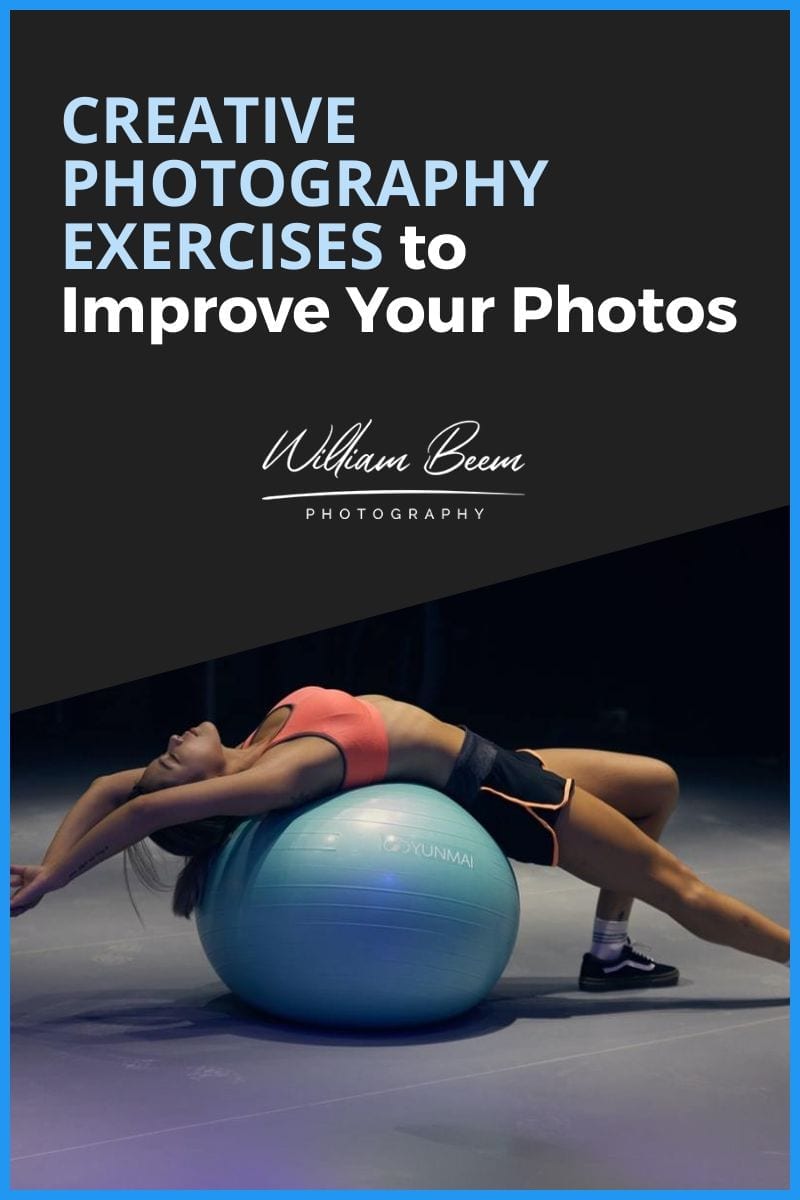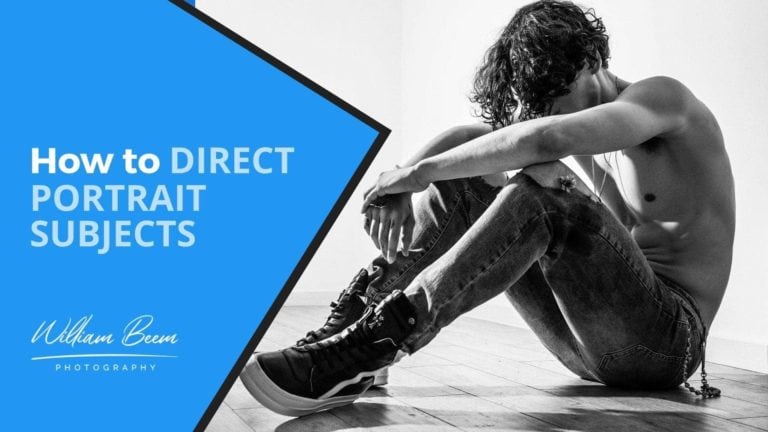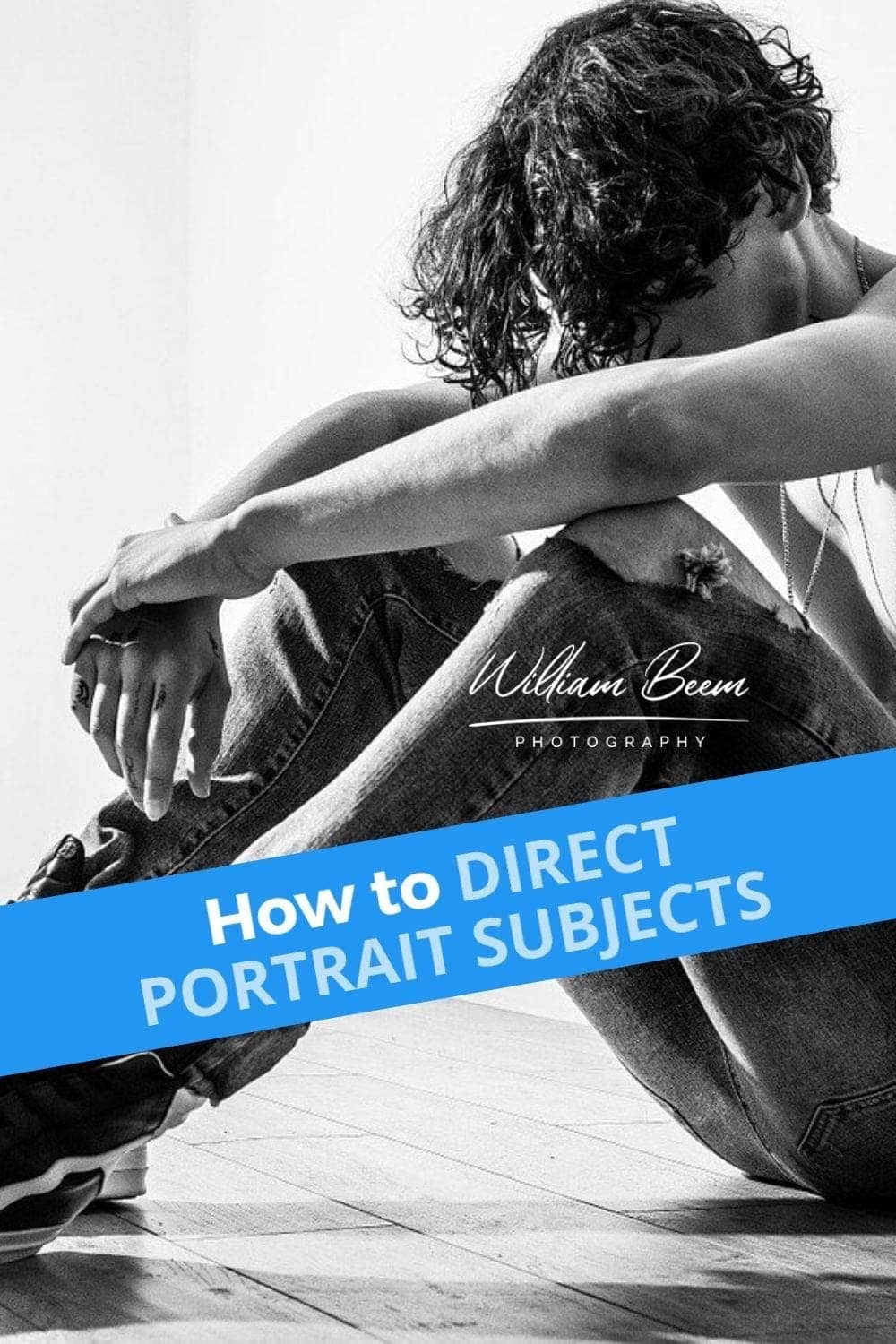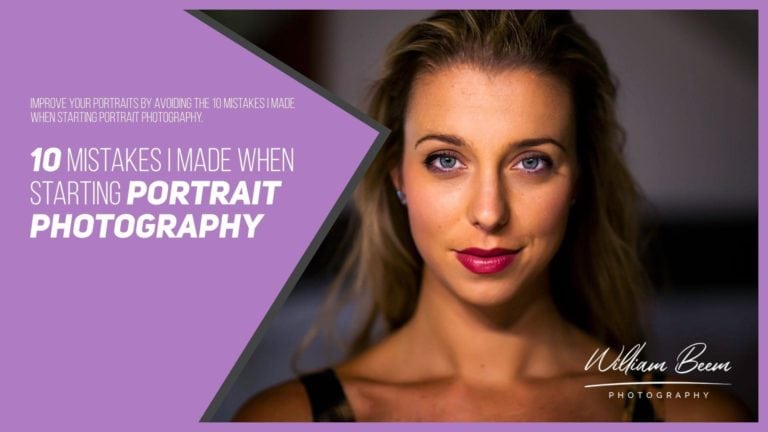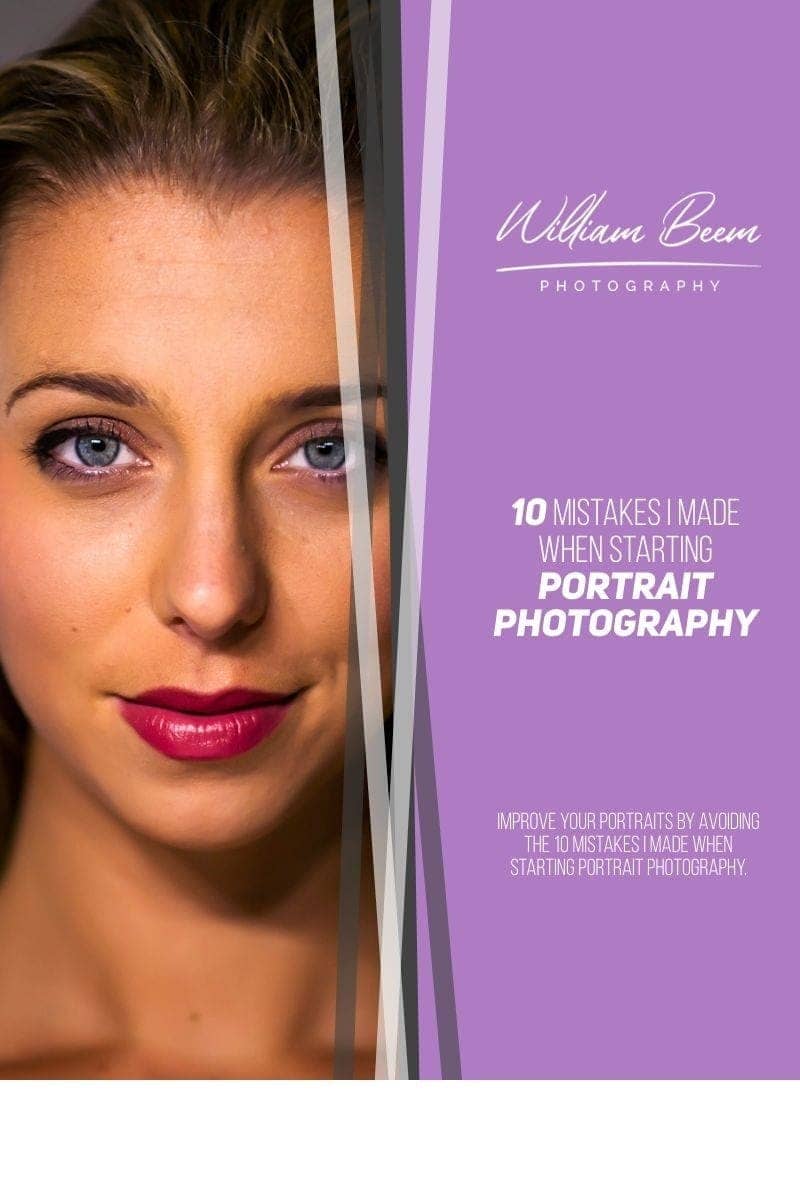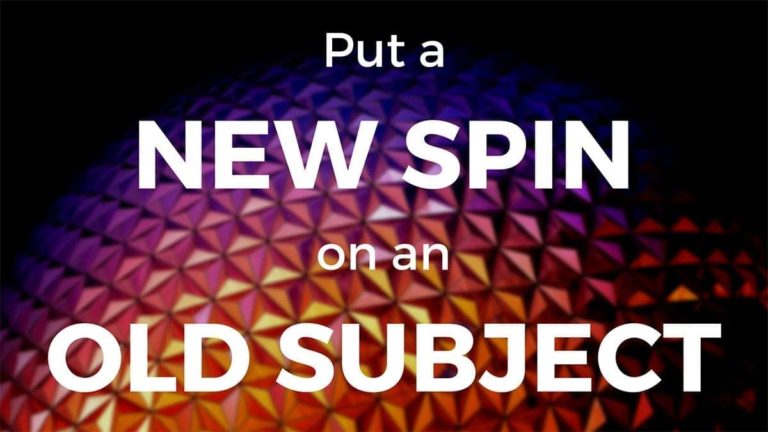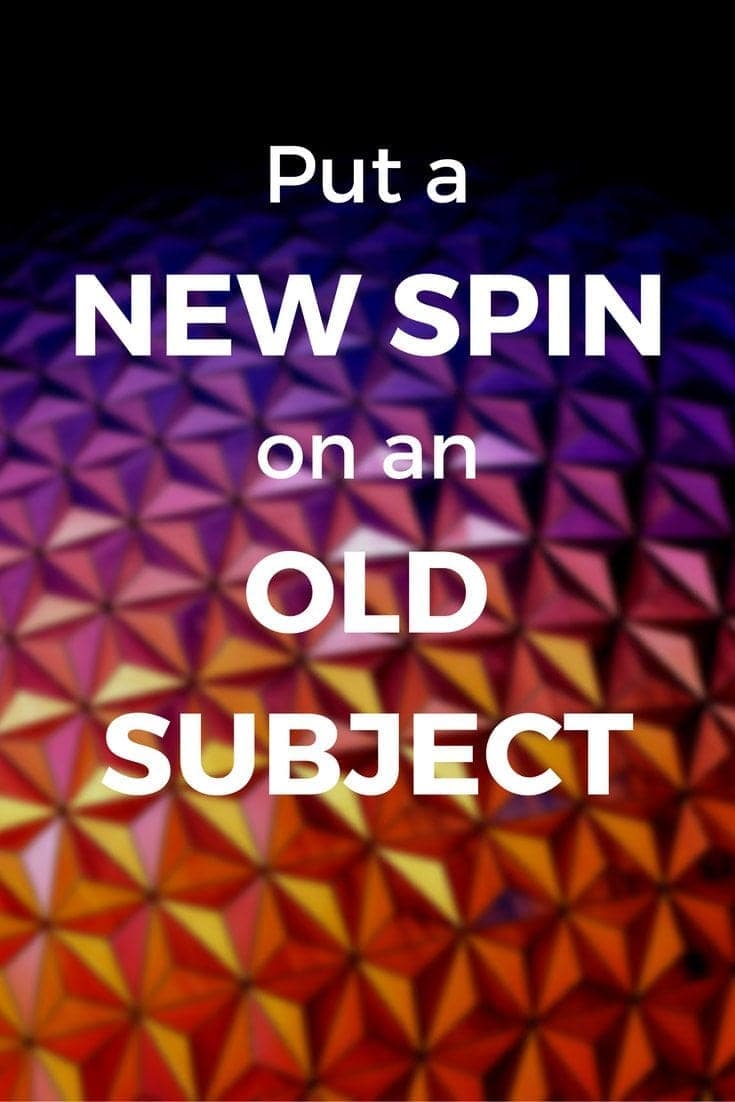Affiliate Disclosure: We earn a commission if you purchase through one of our links at no additional cost to you.
Using creative photography exercises can help you improve your photos, much like drills help athletes react better in their sport. The idea is to train your mind to react without stopping to think. Your abilities increase because of the experience you create.
In this episode, we’ll teach you how to improve your vision and see photographic opportunities that others missed by using creative photography exercises that help you get in peak condition as an artist.
What Are Creative Photography Exercises?
There’s a simple reason why you need to use photography exercises. It’s so you know what to do in almost any situation.
By creating a set of exercises or drills, you become experienced with different aspects of your photography. Using these drills can help you improve in many areas:
- Composition
- Lighting
- Posing
- Use of color
Any area you can define where you need to improve your photography is a good candidate for photography exercises. It’s easier than you think, too.
At its core, every photograph is a combination of subject, light and background. You can create photography exercises to experiment with each of these aspects of a photo.
Photograph your subject from different angles. Use different lenses. Use different exposure settings. Switch up the lighting. Move around your subject to see the result of photos with a different relationship between the camera position, the subject and how the light falls on it.
Try changing backgrounds or recomposing to eliminate part of the background. See how simple you can make your photograph, All of these photography exercises will help you see through the clutter and spot potential for great photos in the future.
Spend time working on an area of weakness and turn it into an area of strength. Experiment with options in whatever area you need to improve. We’ll cover some possibilities in the podcast episode, so give it a listen.
Time Stamps
You know, one of the great benefits that I've gotten from starting up the I Like Your Picture Facebook group is that people tell me things that they're having problems with. And that's why we had an episode earlier on about how to make time for photography, but I'm also hearing some other things. I mean, some people are looking for ways to kind of see through the clutter was one comment that I got and they're looking to improve their photography by seeing things more clearly.
And that's what we're going to talk about today on I Like Your Picture I'm William Beem welcome to I Like Your Picture. The show that helps you improve your photography with visual storytelling. What is visual storytelling? It's a method of approaching your photography with a knowledge of who you're trying to serve with your photos and what emotion you want to make them feel.
We encourage you to concentrate on your subject, light and background to create a photo. Your audience loves. I'm glad you found us. Hi, my name is William Beem. Hi, my name is Lee Beem. All right, today, we want to talk about a few things about helping you basically with some creative photography exercises to improve your photographs. So we want to help you learn how to break through the clutter and see what the opportunities are wherever you're taking your photographs,
whatever genre that you're with. We're going to talk about developing a set of creative exercises, and we're going to talk about working on your problem areas. And the way I see it, the reason this kind of comes about is there's a core problem is I think that your ability to see in advance what the photographic opportunities are. To me, that kind of suggests when I hear somebody telling me,
like, I want to see through the clutter that they're reacting rather than being proactive. Does that sound right to you? It does, I think everyone starts that way. Most people start that way when you're doing something new or haven't been trained to do it because the thing in any creativity, some people just have this inherent gift towards something. I mean,
we all have some kind of areas that we excel in with less training or some people seemingly with none at all. Anything you do to get better at it. You actually have to train your self to do things different. Just like you kind of can train your body to do something, or you can train people to do something. You gotta train your mind or your eye to look at things differently.
And that's going to come with some frustration that is going to come with the feeling of looking at a blank wall sometimes. But that is just part of the reality. You hit on something that I think you're absolutely right. That's the way almost all of us start. I got a camera. What can I go out and find and take a photograph that I'm going to enjoy,
or that I'm going to share with somebody. And it's almost like you're on a scavenger hunt. One of the things that I talk about quite a lot these days is to plan ahead. Pre-visualize what your photograph is going to be. And then kind of create it rather than looking for opportunities. That's not necessarily a fair statement to every photographer because some things you just don't go out and create,
but there are ways that you can go out and find something and make it the best that it can possibly be for your photograph. So for example, if you're into travel or landscape, you don't know necessarily what the day's going to be like. There were some things you can do. So for example, if you want snow, you know, you're not going to go in June.
There are some little things that you can do to control what the aspect is. If you're going to shoot something outdoors and you want to shoot in the best light, then you know that you're probably going to be going for golden hour in the morning or in the evening. But those are not the only times to find great photographs. And I think part of what the problem to break through the clutter and see opportunities is to do what other people in other endeavors do.
This is I started saying like, you know, do what other professionals do, but it's not necessarily just professionals. If you want to be an outstanding guitar player, you practice. You noodle around, you listen to other guitarists and you find ways to determine what your weak spots are. And you practice. If you want to be an outstanding athlete, whatever the sport or competition,
the same thing you practice, and you don't just go practice on games, you do specific drills and exercises to help you make yourself better. That's true. I think for a lot of this, like, especially seeing through the clutter is mostly a case of trying to see a photograph within something that isn't a photograph. I look at it as basically looking at whatever's in front of you and you've gotta be able to crop it.
You look, and you see a sunset and you see all the stuff around when you're looking at something you've got peripheral vision, you've got this kind of wide angle view when you're just standing, looking at something. When you take a photo, it doesn't appear that way because it's gotta be cropped into that, whatever the shape is, of camera sensor is going to capture it.
You can zoom out, you can zoom in, but things appear smaller or maybe they're farther away. So you've really got a look for things and start thinking in terms of your, whatever the dimensions are. You know, you're going to crop it afterwards, most likely to different dimensions, but it's still going to fit into some kind of square rectangular-ish frame.
You're right. Because when you're looking at something, your eyes obviously don't zoom in and out. You don't get to change your angle of view from your vision, but this is where you're going to start moving with your feet. And let me give you a couple of examples. A few years ago, I was in Washington DC and I wanted to photograph of the White House.
The thing with the White House, obviously, is they have that black wrought iron gate. And I didn't want that in my photograph. You know, I'm walking by the sidewalk, I'm thinking this is going to be right in front of my shot. So I put my camera on the tripod. I leaned it forward with, I think I had my 14 to 24 millimeter Nikon lens on there.
And I did a quick bracket, you know, cause I figured I'd either do HDR or I just want to make sure I got it. And as I was finishing up that, that quick click of five shots, one of the security guards came up with the police officers and said, I'm sorry, but you're not allowed to do that. He was a uniformed Secret Service man.
That's what it was. I said, that's fine. I got my shot. That's the moral of the story here, do it. And then when you get told to just apologize and stopped doing it, but you've usually got your photo. I mean, this is whatever, I'm sorry. I didn't see the sign. Well, there was no sign, but that,
but that's okay. But that wasn't really where I was going with this story. What I wanted to talk about was that was the shot that I saw. I didn't have the time or take the time to look, to see what other possibilities there were because I was so concentrating on that gate that I didn't want in my photograph. About a year later,
I saw someone else's photograph taken from way back. I mean, across the street and back in, I don't know if there was a park or was it Lafayette park or something else, but it had the White House, it had the gate and it had more foreground. And honestly, I thought that was a great shot. And in fact, I almost liked it better than the photograph that I took.
So the idea was if I'd worked the scene a bit more, even though I couldn't touch that gate, I may have come up with different shots. And that's where the idea of exercising your options comes into play. If I'd spent more time saying, how can I work this scene? Can I get in close? Can I use a different focal length?
Can I back up and do a wide angle shot? One of the things I see all the time since we live in central Florida, there are rocket launches here continuously. It seems like every time you turn around, there's another rocket going up. Okay. Everybody wants to get as close to the pad as they can. And some people succeed and do that and they get this close up,
you know, the engines taking off, but you know what? There are other photographers who know they can't get in there. They'll get on the beach instead and they'll get this beautiful fire shot of how the rocket goes up and kind of curves off on its way into space. And sometimes the better shot isn't the closeup shot. And I think that's where the exercise comes in is spend some time.
It doesn't have to be a rocket. It doesn't have to be the White House. Pick any subject you want and see how many different photographs can you take of that same place or object, or could be working with a model or lighting, you know, try different lenses, tried different lights and just go through the exercise. What happens if you change your light modifier and move it around?
One of the questions that I get asked, you know, is where do I put the light? Well, it depends on the result you want, but there are some wrong answers, but there are some right answers. But the truth is you never really know until you do it yourself and it clicks and you say, Oh yeah, that's how it works.
Lee you've done the same kind of exercise outside of photography multiple times. I mean, when you started training for your endurance running, you got a plan from somebody and it puts you through, was that speed drills or something, something that you really didn't like. Speed, I didn't like. What was the purpose of all those different drills just to do a marathon?
Well, they challenge up different energy systems. They also challenge up different muscular systems in your body and also by doing so even if the specific one that you're charging up for that workout, isn't the only, you know, the most important one. It kind of keeps your fitness up perhaps while you're not taxing that same, the same system over and over.
So you get a bit of variety in it. So there are multiple purposes, but the simple version is it's all important. Even if it's not specifically what you do. It's for the overall awareness of how to handle what you're doing. Yeah. Look, you can work on a number of different things. Photography is not just picking up a camera and pointing click.
You're thinking about your composition. You're thinking about your colors. You're thinking about your lighting. You're thinking about your perspective. You know, what's your angle of view to your subject. You can make exercises out of each one of those things and say, how do I change this up? How do I change my focal length? How do I change my lighting?
How do I change the way I'm photographing the subject, whether you're doing wide angle view or a very narrow angle view, how close are you to your subject? How does the distortion look with different lenses? I used to go through exercises like that. A matter of fact, I put one on my blog a long time ago. I went out to Walt Disney World at Magic Kingdom.
And I went through an exercise of different focal links, taking pictures of Cinderella castle and the partner statute, which has Walt Disney and Mickey Mouse holding hands in front of it. And I just wanted to see how does that look with different lenses? I started with very wide angle till up to a 200 millimeter. It really changed the way you perceive that particular view.
None of them were wrong, but some of them, I liked better than others. And I wouldn't have really known what to do unless I'd gone through that exercise. Let's say that you want to work on your composition or your creativity. Lee and I were talking over breakfast this morning about drawing. She's, will sit down at a blank page.
And I said, well, what do you do? And I say, I'll let you know. Not sure, But that's okay. In as far as her approach is very different than mine. And we've, we've talked about this before. I want to have my vision of what I'm going to take before I start. Lee will sit down there and figure it out along the way.
Yeah. I'll pick up an ingredient and then kind of start playing with and think, Ooh, this is going to be this. And that's kind of, or sometimes I don't even know. I just started messing around with it and it starts to evolve into something. And I see the vision along the way. All right. So you start with something blank.
It's not necessarily an exercise, but you have to build it as you go. I mean, do you just wait until an idea comes into your head or do you start moving the pencil and paper around until something forms? Nope. I move the pencil or the paintbrush or I start mixing some colors. I basically started working because I find that I get ideas while I'm busy, while I'm moving or just sitting,
staring and trying to think about it. I just don't really get anywhere. You mentioned mixing colors. So sometimes what you're going to create depends upon the colors. And that may come around based upon your mood. Yeah. Photography can be the same thing. Granted, if you're going off and you're taking photographs of something that you can't control, how do you manage the colors with that?
Well, maybe it's the lighting. Maybe it's excluding something that a color that doesn't fit with what you want. Yeah. Or maybe it's focusing on one that you do want in there. Yeah. And maybe you go someplace where there are dominant colors. So for example, if you go to the Southwest, you're going to find those Southwestern colors that are dominant in the architecture.
If you to Santorini, Greece, you're gonna find a lot of white buildings with blue roofs and a beautiful blue ocean beyond it. The idea is that you just pick something to play with. It could be your use of color. It could be your composition. Could be your lighting. Start practicing with it. See what happens when you change something, whether it's change the spot where you're standing,
change the lens, change the lighting, whatever you can change, but basically go out and do some drills. And the idea here is not necessarily to go out and say, Oh, I'm going to take a great photo today. Or I hope I take a great photo today. The idea is to go out and learn how to be creative with your mind and your gear.
Yeah, absolutely. And that's the same thing with, we talked about other endeavors, whether you're, you know, a kickboxer or you're an endurance runner or a tennis player or a chef. When I was working at Le Cordon Bleu, the first thing they had those students do was they gave them a lot of vegetables. They had carrots and celery and onions and tomatoes,
I guess, tomatoes not a vegetable, but they gave them that. And they had their chef knife kit and said, start chopping. We'll show you how it's done. And you're going to be doing this for the rest of your career. And that's true. You are going to be doing it. They start off very slowly. They learn how to position the knife.
They've learned where to put their fingers, you know, both the one on the knife blade and how to make the little claw on their other hand. And it kind of moved that back as they move in with a knife, but it's a skill they build up over repetition. Photography is the same thing. You want to get good at it, do it over and over and over again.
And practice. You know, it's like anything where you've got multiple facets of what you try to learn, which I suppose this most things. It's always overwhelming at first because it feels like there's so many things you have to remember. My approach is always get really good at one things that you don't have to think about it because once that's not dominating my mind,
I can start focusing on something else. So if it's focusing on color, once I kind of feel like it's not the only thing I have to look at, I can start focusing on composition or something different. Just pick one thing. I think everyone looks at all these things. They need to learn. They try and attack everything at once. It's just overwhelming.
There's too much. You don't have to learn to do everything at the same time. It is overwhelming. And it's, it's not just with photography. It's the same thing with any other endeavor. I mean, for example, I'm getting my YouTube channel revitalized. I just completed a list of tutorials for Luminar 4. And now starting to work on the next series that I'm going to do.
I would love to have a channel full of tutorials and videos out there, but I can't. It takes time to create them. It takes time to put them out there. And it also takes time to get feedback from people to see what they like and what they don't like. You know? So I know what's resonating with people is a marathon, not a sprint is the way that the people who are training me call it.
But that's the idea is like, you're not going to plant seeds, water them, and then wake up the next morning and say, Oh, there's a lovely bouquet of flowers here. That would be nice. It wouldn't be. Lee's in her garden. And it takes time. And that's the simple truth of it is that you need to go ahead and take time to do it.
Now I want to tie this back around to the opening statement, where we talked about how do you break through the clutter and see the opportunities? Well, the practice is the way to do it. I think the reason that you see clutter is because you don't know where to begin. And the way to know where to begin is to start exercising your mind and your equipment to find out what they can do.
And then you start thinking about how do these things come together? Am I looking for color? Am I looking for texture or tone? Am I looking for light? Am I looking for architecture? Whatever it is that you think that you're looking for, if you go out there without any kind of plans, just to see what happens, I think everything does look like clutter.
It does. But also I think I'm going to throw the same question. Pretend it's coming from a different angle. Cause it may have been intended this way. And I've got some experience going out with my brother who is really into and good at his landscape photography. And we used to just go out for the sake of hanging out. I'd take my camera as well.
It was really about the social time and I got a lot of practice, but I never really got any photos. If that makes sense. I learned how to work with lights and things like that, but I never really got into landscape photos. I remember walking around with him and he'd get all excited and he'd be crawling around and have his tripod on the ground.
He was, he could see you as really into what he was doing and I'd go and stand behind him and look off like where his lens is pointed. I'm thinking I have what in the world do you see here? Like I just go and see it now. I never did see it. I never trained myself to see it. I probably just didn't have the passion to become a landscape photographer.
But the point is you actually have to figure out what it is that you want to see and start to look for it. So from that perspective, sometimes you don't have a plan. It's just when, when you look at it, like when I looked at stuff, all I saw was like hills and mountains and gray sky, whatever it was, I saw all this stuff,
but I couldn't see a subject. So I'm tackling the question of looking through the clutter from a different direction to where you go out. You don't really have a plan, but maybe you're missing opportunities because you don't see the shot because in front of you, all you see is clutter. And that's, I'm going to say is probably because you haven't tuned into looking at things as it were a photograph. Just going back to what I said earlier in the show.
And that comes with training. There are some people who just have this rare ability, but I think that is really something that comes with training. You walking around. And some people just spot a picture and they'll zoom in. There's this beautiful red flower against some black wall or something like that. And it just looks amazing. And a hundred people could have walked by with cameras and not seen it.
Some people are just, they've trained themselves to see it. Or maybe they're lucky enough to have a natural ability, but you gotta practice looking for that shot. If I'm going to be going out and trying to see, what do I take for a photograph? For example, I used to go on a Scott Kelby's, World Wide Photo Walk. You know that it comes up every year.
I didn't have something in mind that was going to be my subject. I will go out and I first start looking, what is the subject? It could be a person. It could be a place. It could be a thing. That's what I come up with versus. The subject is going to be a person place or thing. Once I've got that,
then I'm thinking, what is my lighting? If the lighting the direction of light, isn't in a pleasing place on that subject, then I need to move. And if I look at that and then I find after I've found the light on the subject and the background is uninteresting, then either it's not the shot that's going to win, or I need to move the subject or maybe I can recompose somehow,
you know, cause or come back at another time, the lights, you know, if I'm dealing with sunlight is going to move well, those are the things I'm looking for. I'm looking for a person place or thing. I'm looking for. Interesting light and a good background. And that really comes down to what I've been saying for a few years now,
subject light and background. If you look at subject light and background, your odds of getting a good photograph, I think are much higher than just going out, snapping things. You know, that frustrating moments happen to all of us. When you've got some... You see something's going to make a perfect shot. And there's some kind of unwanted elements which may be somebody's top of somebody's head or there's stuff in the frame that you cannot move and you cannot move around
it. There's nothing you can do. Sometimes you can get by that from zooming in. Now that may mean that you don't get the shot that you wanted. So maybe it was a picture of a boat and you're trying to get the shot of the boat, but there's a whole bunch of people in front of it you don't really want people in that shot. So you may have to zoom into a portion of the boat.
Maybe you've got like a little interesting piece of it. Might be a little abstract might be, I was looking for a picture. You actually had in here and just remembered we changed them. But you may have to think a little bit differently about the shot that you get. Sometimes you just cannot get that composition that you want, but it doesn't mean you have to walk away with nothing.
No, it doesn't. And. you know, I used to face this frustration when I would go out to Disney all the time, take photographs. I could find, I think a very good composition and a very good photograph. It had a good subject, good light, good background, but I could never control the other guests in the park. And somehow there would always be somebody in some ugly red shorts that would be in my shot.
And that's where I learned patience. Sometimes I have to wait for that person to move and I've waited a long time for some things in order to get the shots that I wanted. The longest I ever waited was five hours to get a stage show that they put on, you know, for Star Wars every year. If you want your shot, you do what it takes.
You have patience to get your spot and get there before anybody else. Or you look for the right background and wait for an interesting subject to come across. Or you find an angle with the lighting that's just really making your subject look good. And hopefully you don't have a cluttered background. In my mind. I still keep coming back to subject, light and background.
And if you can put those things, anything that doesn't belong, like you talked about clutter, you want to distill your subject, light and background into as simple of a scene as you can and remove anything that does not enhance or support that photograph. And if you can't remove them, then move yourself around. And if that doesn't work well, then maybe today's not your day because that's the issue with capturing rather than creating.
It's like Oh, that makes me mad as ever. I hate it when like today's not today. What why? Well, for that shot, it doesn't mean you can't find another shot. And I know what you mean. Cause I came home. You know, sometimes you do go out. If you're trying to go out and capture, sometimes you come home skunked.
You don't get anything. And it's frustrating. And it makes me angry, you know, not throwing my camera in the ocean kind of angry, but it just makes me think like, all right, I didn't get it to there as there was this person in red shorts that just really distracted everything. Yeah. But that's okay. I can go back another day.
Cause I live here. The idea is that you want to simplify as much as you can. And as Lee said, sometimes that means you zoom in or you walk closer. To my shock and surprise, like for that photo of the White House, sometimes you back up. Sometimes the scene is more interesting. Even at Disney, we did this one time with some friends of ours who were staying in the Contemporary,
we were going to do fireworks photographs. I've always done fireworks photographs, right by Cinderella castle. But when we were in the Contemporary, I said, man, they have burst all over the park. You never notice it when you're standing there. And I got a shot that most other people don't get or people who haven't stayed in the Contemporary have visited the balcony stage one on,
I thought this is cool. I liked it. Yep. See, I used to, unlike you, I, once or twice I took, I think only once I took fireworks, like right up at the castle. The other times I tended to go right far back, like much further back on Main street because I like the little glimmery lights on that caught the edges of the buildings.
I kind of liked that little shape that it gave. Cause it made this little, almost like two mountains coming together with the darkness and the little glimmers of light and then the castle and everything was in between. I just kinda like that. I think also coming back to seeing through the clutter, I wanted to get a shot of Cinderella castle with the fireworks.
Then we went way, way back to the shot that I got from the Contemporary and saw the entire Magic Kingdom and how that lights up. And that was a very different experience for me. And then we did what you did was like you got back on Main street and you saw the edges of the buildings, but you also saw all the fans and the guests and the people lining up down Main street and how they reacted.
I really liked having people in my firework shots for some reason, to me, it, that was part of it. I didn't like everywhere else that you go, people are taking photos of fireworks in the sky and there's nothing wrong with it. I've done it as well. But I just wanted to have a photo of the people there. Cause that's part of the whole story of the atmosphere And the story changes depending on where you are.
I mean, I've gone on the reverse side of Cinderella castle and then they've got, this was the Prince Charming's Carousel or whatever it's called Cinderella is they've changed. Whatever it is. It's a carousel with some horses on it. But I got that in the foreground and then the castle and then the streaming bunch of red fireworks lights come on. And it's a different story.
It's a different angle. And I've also done it on the side. There's this little like lazy curvy river. And you see fireworks from that angle. So you stand in different places from your subject, get different angles, get different perspectives and you get different stories. And that's how you learn how to see through the clutter. One thing that I've found that most photographers want,
that's how you get a shot that the other photographers missed. Yeah. Hey, thank you so much for joining us today on I Like Your Picture. This is episode 235. So show notes are going to be available williambeem.com/episode235. Did you like this show? We'd love it if you'd recommend it to a friend and we'd love it even more
if you and your friend would subscribe. just go to Williambeem.com/itunes, or there'll be a place to subscribe on the show notes page. Thank you so much. We'll see you again next week.

